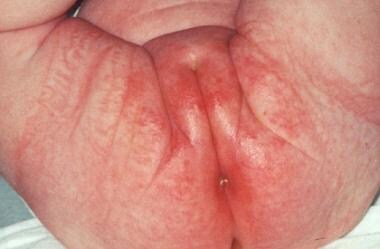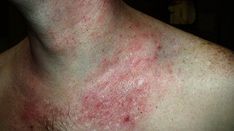Background
Diaper dermatitis is caused by overhydration of the skin, maceration, prolonged contact with urine and feces, retained diaper soaps, and topical preparations and is a prototypical example of irritant contact dermatitis. [1, 2] Signs and symptoms are restricted in most individuals to the area covered by diapers. [3, 4]
The photograph below depicts a 3-week-old female neonate with diaper rash.
Pathophysiology
Diaper rash affects the areas within the confines of the diaper. Increased wetness in the diaper area makes the skin more susceptible to damage by physical, chemical, and enzymatic mechanisms. Wet skin increases the penetration of irritant substances. Superhydration urease enzyme found in the stratum corneum liberates ammonia from cutaneous bacteria. Urease has a mild irritant effect on nonintact skin. Lipases and proteases in feces mix with urine on nonintact skin and cause an alkaline surface pH, adding to the irritation. (Feces in breastfed infants have a lower pH, and breastfed infants are less susceptible to diaper dermatitis.) [5] The bile salts in the stools enhance the activity of fecal enzymes, adding to the effect. pH-balanced wipes and simple washing or rinsing can help restore balance. [6]
Candida albicans has been identified as another contributing factor to diaper dermatitis; infection often occurs after 48-72 hours of active eruption. It is isolated from the perineal area in as many as 92% of children with diaper dermatitis. Other microbial agents have been isolated less frequently, perhaps more as a result of secondary infections.
Etiology of Diaper Dermatitis
The following causes have been noted:
Epidemiology
Race
No racial difference is observed.
Sex
No sexual difference is noted.
Age
Diaper dermatitis commonly affects infants, with peak incidence occurring when the individual is aged 9-12 months. One study determined that at any given time, diaper dermatitis is prevalent in 7-35% of the infant population. [9]
Diaper dermatitis can affect persons of any age who wear diapers, in particular, elderly people.
Prognosis
If treated using the ABCDE acronym (air, barrier, cleansing, diaper, and education), the prognosis is excellent for most patients with diaper dermatitis.
With the exception of an individual who is immunocompromised, no mortality is associated with diaper rash when correctly diagnosed. However, a rash incorrectly diagnosed as diaper dermatitis certainly may lead to significant morbidity and mortality if associated with a serious illness.
Morbidity associated with diaper dermatitis is discomfort and the possibility of secondary bacterial or candidal infection, which may be more severe in an individual who is immunocompromised.
Patient Education
Providing education to the parents and/or caregivers of the patient is important in the treatment and further prevention of diaper dermatitis. [10] Note the following:
-
Keep the skin clean and dry.
-
Provide diaper education. Frequently change diapers. Use disposable diapers with superabsorbent material. When compared with cloth diapers, disposable diapers provide a lower prevalence and severity of diaper dermatitis. [11]
-
Wash genitalia with warm water and mild soap. Wipes may contain sensitizers but can be helpful in some settings. [12]
-
Frequently apply a bland protective topical agent after thorough washing.
For patient education resources, see the Skin Conditions & Beauty Center and Children’s Health Center. Also, see the patient education articles Diaper Rash, Contact Dermatitis, and Skin Rashes in Children.
-
A 3-week-old female infant with diaper rash. Satellite lesions can be observed. The patient was diagnosed clinically with candidal dermatitis and successfully treated with nystatin ointment.











